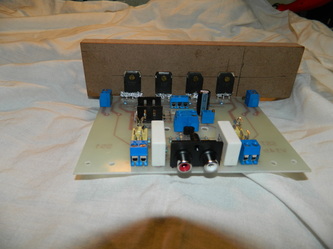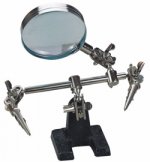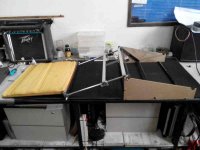just wondering what type of suports or stands are most commonly used at hobby level, I am looking on builing my own mechanism to hold pcb´s so references, requierements and ideas are welcome. 🙂
just wondering what type of suports or stands are most commonly used at hobby level, I am looking on builing my own mechanism to hold pcb´s so references, requierements and ideas are welcome. 🙂
Depending upon the size of the board something like this is pretty common.
PanaVise Circuit Board Holders for less at Howard Electronic Instruments, Inc.
Not an endorsement of the seller or the particular holder - just intended as an example. Let the internet be your friend and look around. A good magnifier glass is a big aid too.
HEI Magnifying Work lights with optional 3 or 5 diopter lens and fluorescent bulb.
One of these
I have one just like that, but i always manage to tip it over ..i guess i could add a flat piece of board and glue the base but then, the little clips scratch the boards...i am not really fond of this design. Thank you for the refference.
Depending upon the size of the board something like this is pretty common.
those look very nicely made, board size will not be bigger than 20x20cm ...
Last edited:
I use the PCSS/2 http://www.mikrocontroller.net/attachment/57741/pcss.pdf . Out of line, $wise, for hobby work, but a Xmas present to self? E
I often just use green masking tape to hold components in place.
I've used a PCSS holder, but the foam doesn't do a great job of holding small components flat on the board.
I've used a PCSS holder, but the foam doesn't do a great job of holding small components flat on the board.
I use the PCSS/2 http://www.mikrocontroller.net/attachment/57741/pcss.pdf . Out of line, $wise, for hobby work, but a Xmas present to self? E
I have access to this monstruosity, which i is great for large pcb's or large production...it looks similar to the PCSS you mention, bit it is way too big for my needs.
I want to make a simple diy solution, as an exercise of design and fun...so I am looking for inspiration
Attachments
for smaller boards I like to use a small multiangle hobby vice
but also have one like shown in post2
don't need anything for bigger boards
when soldering bigger caps I sometimes use the caps to 'carry' the board on the table
and level it with whatever matches
I would certainly like to have one of those stand mounted magnifier
but also have one like shown in post2
don't need anything for bigger boards
when soldering bigger caps I sometimes use the caps to 'carry' the board on the table
and level it with whatever matches

I would certainly like to have one of those stand mounted magnifier

>
> what do you use to hold the pcb when soldering?
>
...gravity and the other fingers!
Three go for the soldering iron,
two for the solder,
you have five left.
That a hand's worth
(although both thumbs are taken).
Just joking.
Not recommended.
But my guitar playing technique got better 😀
_
> what do you use to hold the pcb when soldering?
>
...gravity and the other fingers!
Three go for the soldering iron,
two for the solder,
you have five left.
That a hand's worth
(although both thumbs are taken).
Just joking.
Not recommended.
But my guitar playing technique got better 😀
_
I also tend to use electrical tape to hold components neatly against the board as I solder them in place.
I use nothing for any board or component. For two leaded component, just bend the leads after inserting, solder one lead, push hold it from behind with something not to get heat-burn, and solder again THE point and then the other. For multileaded, do it for two opposite leads and then solder all other.
Board stays on the work table.
Gajanan Phadte
Board stays on the work table.
Gajanan Phadte
I use small wood clamps to hold the pcb on an edge of plywood that is also clamped down to the table or sometimes I just clamp the PCB to the edge of the table.
Something I posted 0n the Construction page for soldering mosfets: http://www.diyaudio.com/forums/construction-tips/241727-mounting-mosfets.html


Gravity keeps the board in place, sometimes assisted by the use of the weight of a handy tool such as a small pair of pliers.
Components kept in place by a slight bending of their leads so they just grip the holes. This also reduces the need for the solder to bridge a gap - on at least one side there is no gap. I generally do resistors first (in batches of 2 or 3), then caps, then semiconductors. I snip the leads to length after soldering, and save the longer cuttings for use as jumpers.
Components kept in place by a slight bending of their leads so they just grip the holes. This also reduces the need for the solder to bridge a gap - on at least one side there is no gap. I generally do resistors first (in batches of 2 or 3), then caps, then semiconductors. I snip the leads to length after soldering, and save the longer cuttings for use as jumpers.
I've got an old (yes ancient) wooden vice ...
interesting 🙂
picture ? (please)
Gravity keeps the board in place, sometimes assisted by the use of the weight of a handy tool such as a small pair of pliers.
Components kept in place by a slight bending of their leads so they just grip the holes. This also reduces the need for the solder to bridge a gap - on at least one side there is no gap. I generally do resistors first (in batches of 2 or 3), then caps, then semiconductors. I snip the leads to length after soldering, and save the longer cuttings for use as jumpers.
All exactly what I do! Those things that hold the board off the table I think are only needed if you are working on a board that already has taller parts fitted, e.g. rework.
And a diy solution
very nice ...something like that is what i hope to came up with...
I am surprised many people do not use anything, I always feel I really need a solid support for the boards
- Status
- Not open for further replies.
- Home
- Design & Build
- Equipment & Tools
- what do you use to hold the pcb when soldering?


